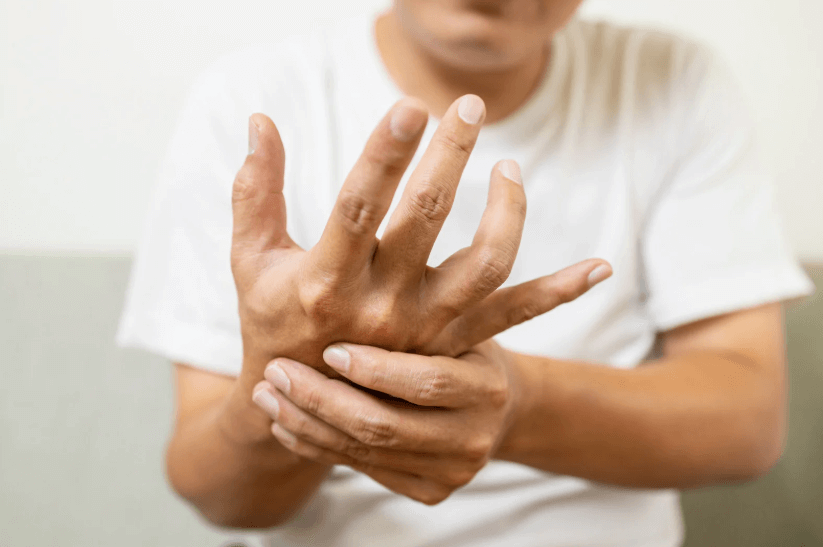If you have ever noticed your finger randomly moving on its own, you might have wondered if it’s a harmless twitch, or something more serious like a tremor.
While finger twitching is common and nothing to worry about, finger tremors can point to an underlying neurological condition - and the two look very similar at first glance. The important thing is to know what to look out for and how the two differ.
Comparison Table: Finger Twitching vs. Tremors
|
Feature |
Finger Twitching |
Finger Tremors |
|---|---|---|
|
Movement Pattern |
Brief, irregular, non-rhythmic contractions |
Rhythmic, oscillatory, sustained shaking |
|
Common Causes |
Stress, fatigue, caffeine, vitamin deficiency, overuse |
Essential tremor, Parkinson’s, MS, thyroid issues, medication side effects |
|
Onset |
Sudden, short-lived, often context-specific |
Depends on type (resting, action, intention) |
|
Seriousness |
Usually harmless; rarely neurological |
More likely linked to neurological or systemic conditions |
|
When to Seek Help |
If twitching persists, spreads, or causes weakness |
If tremors interfere with daily life or worsen over time |
Finger Twitching (muscle fasciculations): These are brief, irregular muscle contractions. Many people describe them as their fingers “shaking on its own” for a few seconds before stopping. They tend to be brief, irregular and non-rhythmic contractions.
Finger Tremors: These are rhythmic, repetitive shaking movements that usually continue over time.
Causes of Finger Twitching
Most people will experience finger twitching at some point, and in the majority of cases, it’s completely harmless. Still, it can be distracting and you might worry it’s something serious, which is why being knowledgeable about the cause can really help.
Common everyday causes:
Muscle fatigue – Overworking your hands during typing, gaming, or manual labor can irritate the small muscles controlling your fingers, causing them to twitch.
Vitamin deficiency – Low levels of vitamin B12, vitamin D, magnesium, or calcium can disrupt nerve signaling, leading to twitching.
Dehydration – Electrolyte imbalances (particularly sodium, potassium, and magnesium) can cause muscles to misfire.
Stress and anxiety – The nervous system reacts to stress with muscle overactivity, sometimes showing up as twitches.
Lack of sleep – Sleep deprivation overstimulates the nervous system, making muscle fasciculations more likely.
Excess caffeine – Too much coffee, energy drinks, or tea overstimulates the muscles and nerves and might make them twitch.
Physical overuse – Repetitive movements such as typing, texting, gaming, or playing an instrument strains your finger muscles. You might find a pattern in how much your fingers twitch, depending if you’ve recently done one of the above activities.
Medication - Some medications can list finger twitching as a side effect. This might be stimulants (such as those used for ADHD), asthma medication and some antidepressants.
Lifestyle Triggers (often harmless)
Lifestyle triggers such as stress, fatigue, dehydration, caffeine and overexertion can also cause finger twitching. Keep in mind it’s often harmless, just more of an annoyance!
Medical Causes (less common, but important)
There are some medical causes that can cause finger twitching. These are less common, but it’s essential to rule them out, as they can be a sign of something more serious. It could indicate:
-
Nerve compression (carpal tunnel, neuropathy)
-
Electrolyte/vitamin deficiencies
-
Endocrine disorders (thyroid issues, hypoparathyroidism)
Less common medical causes – Motor neuron disease (e.g., ALS) or peripheral nerve problems can cause fasciculations. Parkinson’s causes tremor, and Tourette’s involves tics, which are different from twitching.
Finger-Specific Examples
One of the first things to look into is which finger is twitching. If it’s your index/pointer finger, this is likely down to overuse, typing strain or stress.
Middle finger twitching is usually caused by fatigue and nerve irritation. If your index finger is twitching when you’re resting, it might indicate neurological involvement.
However, location alone doesn’t diagnose the cause. Twitching can occur in any finger muscle. Focus on pattern, duration, triggers, and associated symptoms rather than the specific finger.
Causes of Finger Tremors
Unlike finger twitching, tremors are more rhythmic, last for longer and can occur more often. More likely to be related to a neurological condition, it’s important you get it checked out as soon as you can. Tremors can vary in how severe they are, from mild shaking that you only notice when you’re holding something such as a cup of coffee, to a severe tremor that interferes with your everyday tasks.
Benign or Physiological Tremor
It can be normal to have a tremor, and lots of people have ones that are so subtle they go unnoticed. A physiological tremor can become more obvious when you’ve had caffeine, feel stressed, or have low blood sugar. These are harmless and temporary, categorized as a benign or physiological tremor.
Essential Tremor (ET)
An essential tremor is the most common movement disorder and affects millions of people around the world. It tends to be hereditary and worsens during movement such as holding utensils, pouring drinks or writing.
Parkinson’s Tremor
A Parkinson’s tremor is classified as a resting tremor. It appears when the hand is at rest and often improves with movement. It’s known for its classic ‘pill-rolling’ movement, where the thumb and index finger rub together involuntarily.
Other Tremor Types
Other tremor types include:
-
Cerebellar / Intention Tremor – This type of tremor appears when reaching for a target, worsening as you get closer. It’s often linked to cerebellar damage which is caused by something like a stroke, MS, or trauma.
-
Dystonic Tremor – This is associated with abnormal postures. Movements are irregular and can sometimes pause when the hand is in certain positions.
-
Psychogenic or Functional Tremor – Variable in presentation, these are often linked to stress or psychological factors. They might improve with distraction, but this isn’t always the case.
-
Neuropathic Tremor – This is caused by nerve damage in peripheral neuropathies, often seen with diabetic or hereditary nerve disorders.
Red Flags & Diagnosis
So how do you know when finger twitching or tremors need medical attention?
When to See a Doctor
See a doctor if you experience involuntary finger twitching that persists for weeks, spreads to other muscles, or is accompanied by weakness, numbness, or loss of coordination. You should also go if you have tremors that interfere with everyday tasks such as writing, eating, using tools etc. if it worsens over time, or is accompanied by stiffness, slowed movements, or balance issues. While it’s probably fine, it’s always better to get a professional opinion and if it is anything serious, to diagnose it as early as possible.
How Doctors Diagnose Tremors vs. Twitching
There are a few things doctors will do to diagnose if you’re experiencing a tremor or twitching. This includes a physical and neurological exam, blood tests to check your thyroid function, vitamin deficiencies, and electrolyte levels, and an EMG or MRI for complex cases.
How to Stop Finger Twitching & Manage Tremors
Home Remedies & Self-Care
If you are experiencing twitching, there are some things you can do at home to help alleviate your symptoms. Prioritize sleep and rest to help restore your nervous system balance, stay hydrated to prevent electrolyte imbalances, and manage stress to reduce nervous tension. Try deep breathing, meditation and light stretches of your hands. You should also cut back on caffeine and try to rest your hands if you’ve been using them (for example for gaming, or typing) for long periods of time.
Medical Treatments for Tremors
When tremors are really impacting your life, your doctor might recommend:
Medications
Essential Tremor: beta-blockers (propranolol), anticonvulsants (primidone).
Parkinson’s tremor: dopaminergic medications such as levodopa.
Therapies
Physical or occupational therapy to improve muscle control and reduce daily interference.
Advanced Options
Deep brain stimulation (DBS): Electrodes implanted in the brain to control abnormal signals.
Focused ultrasound: Non-invasive treatment for essential tremor.
Nerve Stimulation Devices
You can also use adaptive devices, like the VILIM ball. It is a next-generation, non-invasive handheld medical device — the first and only CE-marked solution specifically developed to reduce hand tremors with advanced AI technology. Its smart algorithms analyze each user’s tremor and personalize therapy in real time.
 Built for people with Essential Tremor and Parkinson’s-related hand tremors, VILIM ball offers a modern, personalized approach to tremor management.
Built for people with Essential Tremor and Parkinson’s-related hand tremors, VILIM ball offers a modern, personalized approach to tremor management.
FAQs
Why is my finger twitching?
Most finger twitching comes from stress, fatigue, or too much caffeine. It’s usually harmless and temporary.
Why is my index finger twitching at rest?
If your index finger twitches while at rest and it happens often, it could signal nerve irritation or, in rare cases, a neurological condition. Persistent symptoms should be checked by a doctor.
Why does my index finger keep twitching after typing or gaming?
Overuse of finger muscles during typing or gaming can trigger twitching. Stretching, resting, and reducing repetitive strain usually help.
What’s the difference between finger twitching and tremors?
Twitching is brief and irregular; tremors are rhythmic and ongoing. Tremors are more likely linked to conditions like essential tremor or Parkinson’s disease.
When should I worry about finger twitching?
If twitching lasts more than a couple of weeks, spreads to other areas, or comes with weakness or numbness, you should see a healthcare professional.
Can finger spasms and twitching be the same thing?
Finger spasms involve sudden, painful muscle contractions, while twitching is usually painless and shorter in duration.
How do I stop my fingers from shaking?
Mild tremors may improve with stress reduction, reducing caffeine, and rest. Persistent or worsening tremors may need medical treatment.
Are finger tremors normal?
Mild hand tremors can be normal, especially with fatigue, stress, or caffeine. Persistent or worsening tremors should be evaluated.
Key Takeaways
Finger twitching is usually harmless and short-lived, but persistent involuntary twitching may require medical advice. It’s best to get this sooner rather than later to keep it manageable.
Finger tremors are rhythmic and may indicate underlying neurological conditions, whereas finger twitching is less often, doesn’t have a pattern and is harmless. Lifestyle changes help mild cases of finger tremors, however, persistent or disruptive symptoms need medical evaluation.



Dalintis:
Non-Essential vs Essential Tremor: What’s the Difference?
Why Do My Hands Shake? Hand Tremor Causes, Types & Treatment